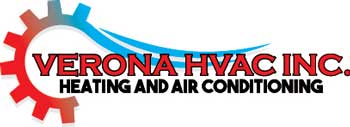
Ceiling fans are one of the most underappreciated ways to increase home comfort and reduce energy costs. By improving air circulation and working in conjunction with your HVAC system, ceiling fans and energy efficiency are truly a match made in heaven. They offer a smart, cost-saving way to maintain your comfort in hot weather while lessening strain on your AC—potentially sparing you from unnecessary air conditioning repair.
In this blog, the experts at Verona HVAC discuss how ceiling fans can improve your comfort while lowering your energy use with higher HVAC efficiency. We'll also provide some HVAC efficiency tips that make the most of ceiling fans.
Comfort vs. Temperature: The Effect of the Wind-Chill Effect Indoors
Ceiling fans don’t actually lower the room temperature—they make you feel cooler by blowing air across your skin. This is known as the wind-chill effect, and it can make a room feel up to 4 degrees cooler without adjusting the thermostat. That means you remain cool and enjoy the benefits of indoor air circulation from your ceiling fan while relying less on your air conditioner—helping reduce your electric bill in summer.
The Best of Both: Advantages of Pairing Fans and Air Conditioning Together
There are several advantages to using ceiling fans and air conditioning in tandem, especially during the warmer months. By pairing both, you boost HVAC efficiency and enjoy a cooler living space with less work from your cooling system.
Why you should use ceiling fans and AC together:
- Ceiling fans help lower HVAC load by moving cool air more evenly throughout rooms in your home. Reducing HVAC stress is important, because it can prevent a breakdown that may lead to premature AC or furnace installation.
- Using overhead fans enhances comfort by eliminating hot spots and increasing airflow.
- Pairing ceiling fans and AC can cut energy consumption. If you have a home automation system, you can even modify your smart thermostat settings to set the temperature higher while your ceiling fan is running.
Clockwise vs. Counterclockwise Ceiling Fan Rotation: Which is the Correct Direction?
To maximize the benefits of your ceiling fans year-round, it’s important to make sure the blades rotate in the right direction for the season. The direction influences how air circulates, which can either cool you down or redistribute heat so you feel warmer.
When to spin ceiling fans counterclockwise
On hot days, ceiling fans should rotate counterclockwise at a quick speed. This creates a breeze that pushes cool air downward, amplifying the wind-chill effect and making you feel cooler.
When to spin ceiling fans clockwise
In the winter, set your fan to turn clockwise on a slower speed. This lifts cooler air and pushes warm air near the ceiling down toward you, making the space feel cozier without touching your thermostat.
How to Pick Out the Best Ceiling Fan for My Home
Choosing the right ceiling fan depends on a few key factors, such as blade design, airflow rating and room dimensions. First, look for fans with a good combination of ECFM airflow and blade pitch to provide efficient air circulation in your space:
- ECFM is how much air a fan pushes—the cubic feet per minute, or CFM—per watt of electricity it uses. Fans with greater ECFM are the most energy efficient.
- Blade pitch is the incline of the blades. A sharper blade pitch increases airflow but can also put extra load on the motor.
Also, consider room size when sizing a ceiling fan—a fan that’s too small won’t move as much air as you'd like, while one that’s too large may be overpowering for the room.
Boost Your HVAC Efficiency With the Team from Verona HVAC
At Verona HVAC, our HVAC specialists can help you maintain a cozy home while minimizing wear on your heating and cooling systems. From energy-saving ceiling fan tips and air conditioning installation to smart thermostats and furnace repair, we offer comprehensive solutions that fit your lifestyle. Set up your appointment by calling 661-449-9765 today.
